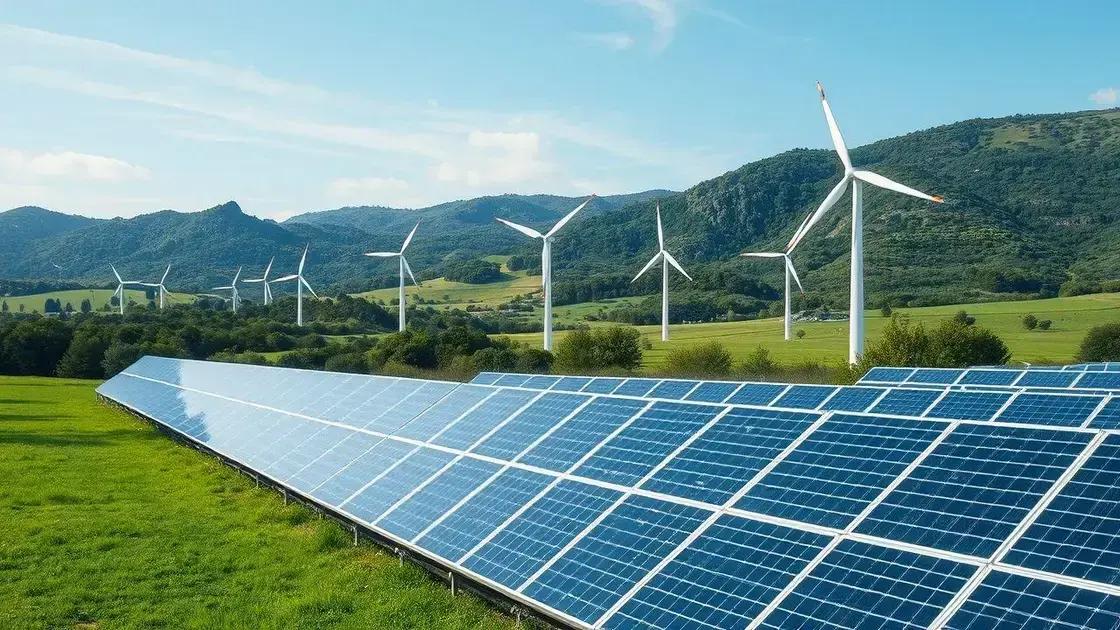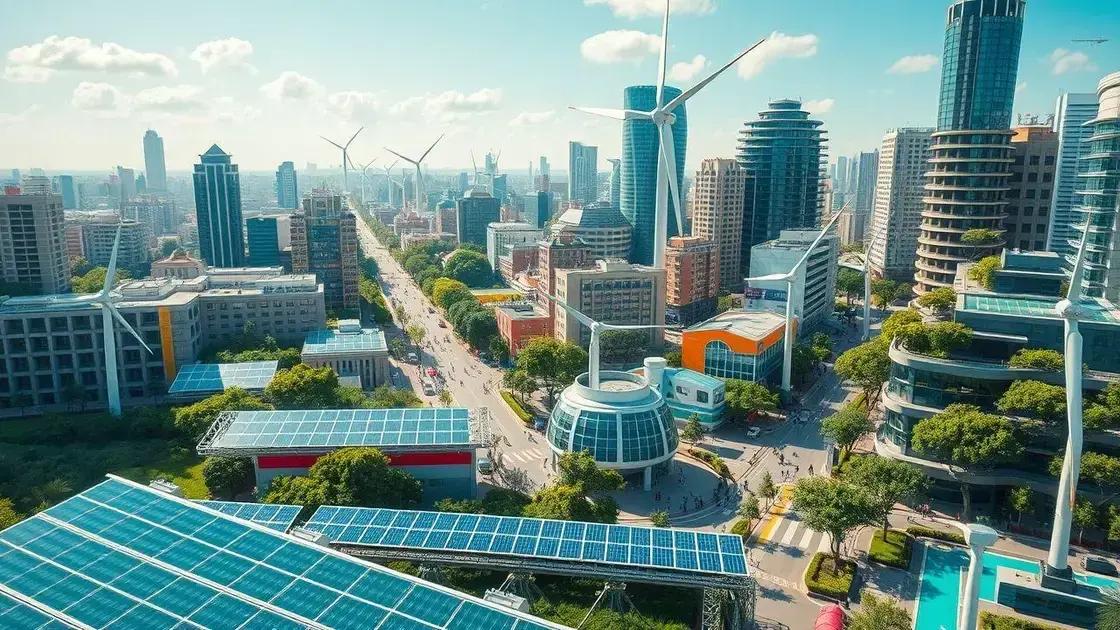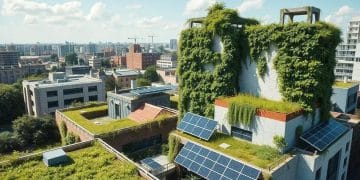Renewable energy expansion trends in focus for 2024

Renewable energy expansion trends indicate a significant shift towards sustainable energy sources, driven by technological advancements, policy support, and increasing public awareness, despite challenges like high initial costs and infrastructure limitations.
Renewable energy expansion trends are reshaping how we think about energy consumption and sustainability. As the world shifts towards greener solutions, understanding these trends can help us adapt and flourish in various sectors.
Current trends in renewable energy
The current trends in renewable energy reflect a significant shift in how nations approach energy production and consumption. As technology advances and public awareness grows, there is an increasing demand for sustainable energy solutions.
Solar Power Growth
Solar energy has become one of the fastest-growing renewable energy sources. In many places, solar panels are now a common sight on rooftops and in large solar farms. Governments and individuals are investing in solar technology to harness the power of the sun effectively. This trend is driven by decreasing costs, improved efficiency, and strong incentives for clean energy adoption.
Rise of Wind Energy
Wind energy is also experiencing rapid expansion. Over the past decade, wind farms have popped up in both rural and offshore areas. These installations harness wind currents to generate electricity. The efficiency of wind turbines has improved, making them a more reliable energy source than ever before.
- Technological innovations to enhance output.
- Increased offshore installations for better energy capture.
- Growing investment in hybrid systems combining wind and solar.
Moreover, many countries are setting ambitious targets for renewable energy generation. This drive not only supports local economies but also aims to reduce carbon footprints significantly. By diversifying energy sources, nations can ensure energy security while contributing to global sustainability.
Energy Storage Solutions
Another essential trend is the development of energy storage solutions. As renewable energy sources like solar and wind are variable, energy storage is crucial for balancing supply and demand. Innovations in battery technology are making it easier to store excess energy for later use. This advancement helps to stabilize electrical grids and makes clean energy more reliable.
- Advanced lithium-ion batteries leading the way.
- Emerging technologies like flow batteries.
- Integration of storage into renewable energy systems.
The emergence of smart grids is also crucial in this context. By leveraging digital technologies, smart grids can better integrate renewable energy sources and manage energy distribution efficiently. These systems enable real-time monitoring and allow for a dynamic response to energy demands.
In conclusion, the current trends in renewable energy indicate a robust shift toward sustainable options. As more innovations arise, we can expect even greater advancements that will influence how we produce and consume energy in the future.
Impact of technology on energy expansion

The impact of technology on energy expansion is profound and multifaceted. From solar panels to smart grids, technological advancements play a crucial role in enhancing the efficiency and reach of renewable energy.
Advancements in Solar Technology
One major development is the improvement in solar technology. Panels have become more efficient and cost-effective, allowing wider adoption. This progress helps households and businesses transition to solar energy, reducing reliance on fossil fuels.
New innovations, such as bifacial solar panels, capture sunlight on both sides, maximizing energy production. Alongside this, the integration of solar energy with building infrastructure is becoming more common.
Smart Grid Innovations
Smart grid technology revolutionizes how electricity is distributed and consumed. By using digital communication, smart grids enhance the management of renewable energy sources, allowing for real-time adjustments based on consumption patterns. This adaptability helps balance supply and demand more effectively.
- Increased reliability through automated monitoring.
- Enhanced energy efficiency with smart meters.
- Encouraging consumer participation in energy management.
Moreover, this technology enables better integration of various renewable sources, making it easier to use them collectively. As more homes adopt these systems, energy becomes more manageable, leading to a decrease in waste.
Battery Storage Developments
Battery storage solutions also significantly impact energy expansion. Modern batteries allow for surplus energy to be stored for later use, solving the intermittency issues associated with some renewable sources. Innovations like solid-state batteries promise higher capacity and safety, making renewable energy more viable for everyday use.
With advanced batteries, energy produced during sunny or windy days can power homes during peak demand times. This flexibility supports a smoother energy transition and reduces stress on the grid.
Ultimately, the influence of technology on energy expansion cannot be overstated. Continuous innovations will shape the future of energy, contributing to a more sustainable and reliable energy landscape.
Challenges facing renewable energy adoption
There are several challenges facing renewable energy adoption that can hinder progress toward sustainable energy solutions. As the demand for green energy increases, these obstacles need to be addressed to facilitate a smooth transition.
High Initial Costs
One of the most significant challenges is the high initial costs associated with renewable energy technologies. Although prices have decreased in recent years, the upfront investment for solar panels, wind turbines, and battery storage systems can be substantial. Many individuals and businesses may find it difficult to justify these expenses, especially without immediate financial incentives.
Infrastructure Limitations
Infrastructural limitations also pose challenges for adoption. Many existing power grids are not equipped to handle the decentralized nature of renewable energy sources. Upgrading these grids can require significant investment and time, making it hard for new energy producers to connect and distribute their electricity effectively.
- Need for smart grid technology enhancements.
- Integration of various energy sources for efficiency.
- Expansion of transmission lines to remote areas.
Moreover, some locations may lack the necessary infrastructure to support large-scale renewable projects. This can delay the deployment of clean energy solutions, impacting potential growth.
Regulatory and Policy Barriers
Furthermore, regulatory and policy barriers can complicate the adoption of renewable energy. Inconsistent policies between regions can create confusion for investors and developers. Without a stable policy environment, long-term planning and investment in renewable projects become more challenging.
Additionally, some existing regulations favor traditional fossil fuel industries, discouraging investment in cleaner alternatives. This imbalance can slow the growth of renewable energy and maintain a reliance on non-renewable sources.
Public perception also plays a role in the adoption of renewable energy. While awareness is growing, misconceptions about the sustainability and reliability of renewable sources persist. This can influence consumer behavior and impact investments.
In summary, addressing the challenges facing renewable energy adoption will be essential for creating a more sustainable future. Collaboration among governments, industries, and communities will play a vital role in overcoming these obstacles.
Future predictions for renewable energy growth

The future predictions for renewable energy growth are promising and suggest a transformative shift in the global energy landscape. As advancements continue, more people are expected to turn to renewable sources for their energy needs.
Increasing Adoption of Renewable Technologies
One of the key trends is the anticipated increase in the adoption of renewable technologies. As public awareness of climate change grows, individuals, businesses, and governments are more likely to invest in solar, wind, and other clean energy technologies. This transition is not just about sustainability; it is also driven by economic benefits.
Enhanced Infrastructure and Energy Storage
Improvements in energy storage solutions will significantly impact growth. As battery technology advances, renewable energy sources will become more reliable. People can store energy generated during sunny or windy days and use it when demand peaks. This reliability will encourage more users to transition to renewable energy systems.
- Development of cost-effective battery solutions.
- Integration of renewable energy into existing grids.
- Smart technologies to optimize energy usage.
Additionally, many regions are expected to invest in building infrastructure that supports renewable energy. Upgraded power grids will enable better distribution and management of energy resources. This shift will make it easier for consumers to access and utilize clean energy.
Global Policy Changes
Future predictions also point to significant changes in global energy policies. Governments are likely to implement stricter regulations on fossil fuels and provide more incentives for renewable energy investments. These policies will encourage corporations and individuals to adopt greener practices.
Furthermore, international agreements focused on reducing carbon emissions will drive countries to commit to renewable energy targets. These agreements can create a global momentum that accelerates the growth of the renewable sector.
The rise of innovative technologies will also transform the energy landscape. Companies are investing in new approaches such as bioenergy, geothermal, and tidal energy. These alternative sources will diversify the energy mix, reducing dependency on fossil fuels.
Overall, the future predictions for renewable energy growth indicate an exciting path forward. As awareness, technology, and policies align, the transition to renewable energy will be faster than ever before.
FAQ – Frequently Asked Questions about Renewable Energy
What are the main types of renewable energy sources?
The main types of renewable energy sources include solar, wind, hydroelectric, geothermal, and biomass energy.
How does renewable energy impact the environment?
Renewable energy reduces greenhouse gas emissions, helping to combat climate change and decrease air pollution.
What are the economic benefits of adopting renewable energy?
Adopting renewable energy can lead to job creation, energy independence, and lower energy costs over time.
What challenges do we face in transitioning to renewable energy?
Challenges include high initial costs, infrastructure limitations, regulatory barriers, and the need for improved energy storage solutions.





